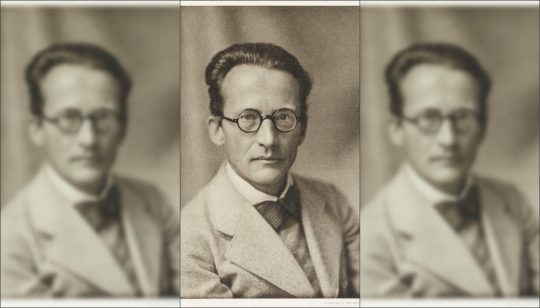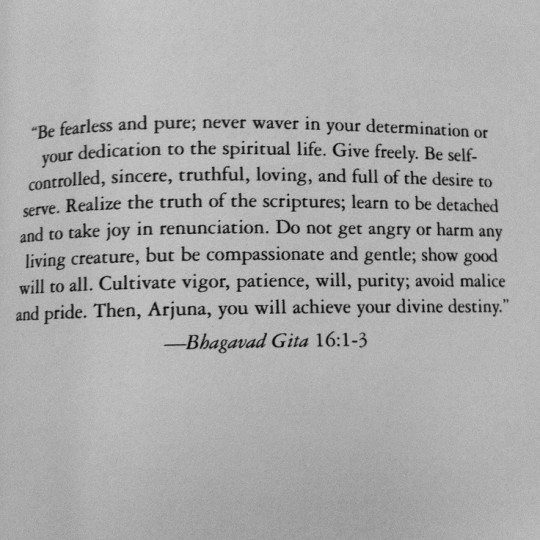#indian philosophy
Text
Ramanuja (vs Hume et. al.): "...the essential character of consciousness or knowledge is that by its very existence it renders things capable of becoming objects...of thought and speech. This consciousness...is a particular attribute belonging to a conscious self and related to an object; as such it is known to every one on the testimony of his own self--as appears from ordinary judgments such as 'I know the jar,' 'I understand this matter,' 'I am conscious of (the presence of) this piece of cloth.'
...we clearly see that this agent (the subject of consciousness) is permanent (constant), while its attribute, i.e., consciousness, not differing herein from joy, grief, and the like, rises, persists for some time, and then comes to an end. The permanency of the conscious subject is proved by the fact of recognition, 'This very same thing was formerly apprehended by me.'
...
...But the fact is that the state of consciousness presents itself as something apart, constituting a distinguishing attribute of the I, just as the stick is an attribute of Devadatta who carries it. The judgment 'I am conscious' reveals an 'I' disginguished by consciousness; and to declare that it refers only to a state of consciousness--which is a mere attribute--is no better than to say that the judgment 'Devadatta carries a stick' is about the stick only..."
7 notes
·
View notes
Text

The philosophy of Upanishads
#upanishads#bibliophile#quotes#literary#literature#western literature#philosophy#philosopher#indian philosophy#indian literature#the philosophy of upanishads
51 notes
·
View notes
Photo

In his 1944 book What is Life?, Schrödinger took on a peculiar line of thought. If the world is indeed created by our act of observation, there should be billions of such worlds, one for each of us. How come your world and my world are the same? If something happens in my world, does it happen in your world, too? What causes all these worlds to synchronise with each other?
He found his answer, again, in the Upanishads. “There is obviously only one alternative,” he wrote, “namely the unification of minds or consciousnesses. Their multiplicity is only apparent, in truth there is only one mind. This is the doctrine of the Upanishads.”
He sought Indian philosophy not to replace the methods of science but to be inspired. He was aware that mixing two systems of thought separated by thousands of years was not easy. He believed Western thought needed to borrow ideas from Indian philosophy – with great care. As he wrote,
“I do believe that this is precisely the point where our present way of thinking does need to be amended, perhaps by a bit of blood-transfusion from Eastern thought. That will not be easy, we must beware of blunders — blood-transfusion always needs great precaution to prevent clotting. We do not wish to lose the logical precision that our scientific thought has reached, and that is unparalleled anywhere at any epoch.”
Apart from philosophy, Indian thinkers have made vital scientific contributions to astronomy, mathematics, literature, law, biology, psychology and most other realms of human endeavour, if not all of them. They often do not receive the recognition due them. However, these instances of overlooking – no matter how severe – can never be corrected by attributing dubious achievements to these or other Indians.
The Upanishads themselves preach a message of unity and are opposed to any form of discrimination. To adapt the words of the Isha Upanishad, “Who sees all beings in their own self and their own self in all beings, loses all hatred and fear.”
[The Wire]
57 notes
·
View notes
Text

Jiddu Krishnamurti- a philosopher, speaker and writer. (art: papercutting)
#jiddu krishnamurti#eastern philosophy#philosophy#eastern philosopher#indian#indian philosophy#indian philosopher#lecturer#teacher#papercutting#papercut#paper#paper cutout#paper cutting#papa osmubal
2 notes
·
View notes
Text
maya (Indian philosophy)
(Sanskrit: “magic” or “illusion”): a fundamental concept in Hindu philosophy.
Maya originally denoted the magic power with which a god can make human beings believe in what turns out to be an illusion.
By extension, it later came to mean the powerful force that creates the cosmic illusion that the phenomenal world is real. Maya is reflected on the individual level by human ignorance of the real nature of the self, which is mistaken for the empirical ego but which is in reality identical with brahman.
#maya#indian philosophy#philosophy#hindu philosophy#illusion#reality#words#vocabulary#dictionary#linguaphile
2 notes
·
View notes
Text
Indian philosophy is so cool I recommend it to everyone. I’m taking a course on it and it blows my mind all the time - like yes, it makes complete sense that we are Brahman and therefore also the universe and Isvara. One of my most peaceful yet insightful courses!
#indian philosophy#seriously#like it’s so much fun#and refreshing cause it’s super different from western philosophy
1 note
·
View note
Text

Discussing about Indian philosophies and their possible applications in a cyberpunk dystopia
0 notes
Text
Shiksha O ManoBigyan by Bijoy Kr Bhattacharjya PDF
Shiksha O ManoBigyan by Bijoy Kr Bhattacharjya PDF.
Book Name – Shiksha O ManoBigyan (Education and Psychology),
Contributor Author – Bijoy Kumar Bhattacharjya,
Genre – Historical Books,
Subject – Social Science and Education,
Book Format – PDF,
Book Pages – 460,
PDF Size – 29MB,
Bijoy Kr Bhattacharjya wrote the Educational Book Shiksha O ManoBigyan (Education and Psychology).
Our country’s…

View On WordPress
#Bijoy Kr Bhattacharjya#Historical Book#Indian Philosophy#Shiksha O ManoBigyan#Social Science and Education
0 notes
Text
The Infinite and Beyond
Contemplating Brahman and Para-BrahmanIn the profound depths of Indian philosophy, the concepts of Brahman and Para-Brahman emerge as pivotal ideas that transcend ordinary comprehension, inviting seekers to explore the very edge of cosmic understanding. Brahman is often described as the ultimate reality, the unchanging, infinite, immanent, and transcendent reality that is the Divine Ground of all…

View On WordPress
#Absolute#brahman#Cosmic Consciousness#Enlightenment#Existential Wonder#Indian philosophy#Ineffable Mystery#Non-Duality#Para-Brahman#Spiritual Pursuit#Transcendence#Ultimate Reality
1 note
·
View note
Text
Chandogya Upanishad is as old as Brhadaranyaka Upanishad and together they rank among the oldest Upanishads. Chandogya Upanishad was written on the Vedic Brahmana period about ninth to eighth century BC. Chandogya Upanishad is associated with Samveda. It is ranked ninth in the Muktika canon of hundred and eight Upanishadas.
https://www.indianetzone.com/14/chandogya_upanishad.htm

0 notes
Text

1 note
·
View note
Text
You know you can achieve everything by just reading this MASTERPIECE!
The Bhagavad Gita is a significant Hindu scripture that is part of the ancient epic, Mahabharata. It consists of 18 chapters of teachings by Lord Krishna to Prince Arjuna on the battlefield of Kurukshetra. The teachings of the Bhagavad Gita are focused on the concept of dharma, or duty, and the pursuit of liberation from the cycle ofbirth and death through devotion to God. The Bhagavad Gita stresses the importance of selfless action, devotion, and detachment as a means of attaining spiritual enlightenment. It is considered one of the most important and influential texts in Hinduism and has been translated into numerous languages worldwide. The Bhagavad Gita has inspired and influenced many great thinkers, including Mahatma Gandhi, who regarded it as a spiritual guide for his own life and work.

The Bhagavad Gita is a 700-verse Hindu scripture that is part of the epic Mahabharata. It is a dialogue betweenthe warrior Arjuna and Lord Krishna, his charioteer and guide, on the battlefield of Kurukshetra. The conversation takes place just before the start of a great battle, and Arjuna is conflicted about the prospectof fighting and killing his own relatives and teachers. Lord Krishna imparts the knowledge of yoga, karma, dharma, and bhakti to Arjuna, encouraging him to take up his duty as a warrior and fight for the greater good.The Bhagavad Gita is considered as one of the most important Hindu scriptures and is revered as a spiritual and philosophical guide. It presents the idea of human life as a journey towards self-realization and emphasizes the importance of action, detachment, and devotion to God.The teachings of the Bhagavad Gita have influenced Indian culture and philosophy for centuries. It has been translated into many languages and has been studied by scholars, philosophers, and spiritual seekers all over the world. It is regarded as a timeless classic, and its messages continue to inspire countless people to this day.
Bhagavad Gita teaches you how to handle that knowledge. It not only inculcates in you, the right and unbiased perspective of observing and knowing your own self as well as the entire creation but also teaches you how to handle that knowledge acquired through such observance.
#bhagavadgītā#spiritual quotes#goddess#indian philosophy#gita#life path#Guidetoeveryquestion#reading#karma#patience#Peace#way of living#Wayofthinking#strength#strength quotes#believe in god
1 note
·
View note
Text
The Beginner's Guide to Understanding the Rigveda
Introduction:
The Rigveda is an ancient sacred text of India that is considered one of the oldest and most important texts in Hinduism. It offers valuable insights into ancient Indian civilization, religion, and culture, and remains a mystery to many people. In this beginner’s guide, we will explore the key concepts and themes in the Rigveda to help you gain a better understanding of this…
View On WordPress
#Ancient texts#ancient wisdom#Dharma#Hindu gods and goddesses#Hindu scriptures#Hinduism#Hymns#Indian culture#Indian history#Indian mythology#Indian philosophy#Mythology#Religious texts#Rigveda#Rituals#Sacred texts#Sanskrit#Spiritual texts#Vedas#Vedic period
1 note
·
View note
Text
The Broken Scale

Lisa, a poorly dressed lady with a look of defeat on her face, walked into a grocery store. She approached the owner of the store in a most humble manner and asked if he would let her charge a few groceries. She softly explained that her husband was very ill and unable to work. They had seven children and they needed food.
John Longhouse, the grocer, scoffed at her and requested that she leave his store. Visualizing the family needs, she said: "Please, sir! I will bring you the money just as soon as I can." John told her he could not give her credit, as she did not have a charge account at his store.
Standing beside the counter was a customer who overheard the conversation between the two. The customer walked forward and told the grocer that he would stand good for whatever she needed for her family.
The grocer said in a very reluctant voice, "Do you have a grocery list?" Lisa replied, "Yes sir." "Okay" he said, "put your grocery list on the scales and whatever your grocery list weighs, I will give you that amount in groceries."
Lisa hesitated a moment with a bowed head. Then she reached into her purse and took out a piece of paper and scribbled something on it. She then laid the piece of paper on the scale carefully with her head still bowed.
The eyes of the grocer and the customer showed amazement when the scale went down and stayed down. The grocer, staring at the scales, turned slowly to the customer and said begrudgingly, "I can't believe it." The customer smiled and the grocer started putting the groceries on the other side of the scales.
The scale did not balance so he continued to put more and more groceries on them until the scales would hold no more. The grocer stood there in utter disgust.
Finally, he grabbed the piece of paper from the scales and looked at it with greater amazement. It was not a grocery list. It was instead a prayer which said: "Dear Lord, you know my needs and I am leaving this in your hands."
The grocer gave her the groceries that he had gathered and stood in stunned silence. Lisa thanked him and left the store. The customer handed a fifty-dollar bill to the grocer and said, "It was worth every penny of it."
It was sometime later that the grocer discovered the scales were broken; therefore, only God knows how much a prayer weighs.
1 note
·
View note